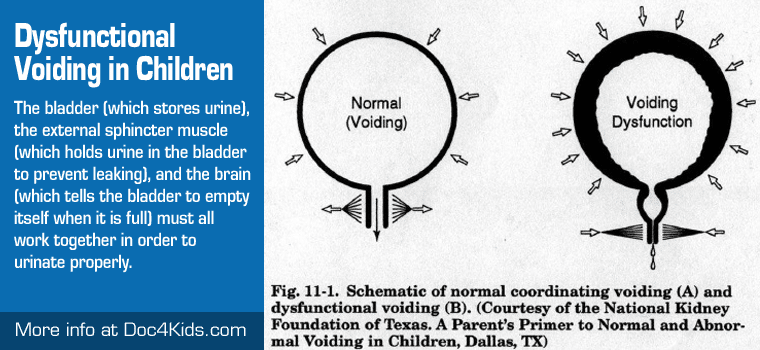DYSFUNCTIONAL VOIDING (A COMMON CHILDHOOD PROBLEM) Bladder Issues
Your child has a condition known as Dysfunctional Voiding. This means that the various parts of the urinary tract may not be working together in a coordinated way. The bladder (which stores urine), the external sphincter muscle (which holds urine in the bladder to prevent leaking), and the brain (which tells the bladder to empty itself when it is full) must all work together in order to urinate properly. With time, most children do this naturally; however, it is quite common to see children with problems. Often the beginnings of the problem can be traced to an event that has caused emotional anxiety for the child such as death, divorce, a new sibling, a recent move, or a parent on a long Navy cruise.
Dysfunctional voiding results when the brain, bladder and the sphincter muscle work against each other rather than together as they should. Symptoms of dysfunctional voiding include urinary frequency, urinary urgency, pain during urination, wetting, abdominal pain, and occasional constipation. An unbalanced urinary tract, which does not empty the urine completely, may allow bacteria to grow in the retained urine resulting in urinary tract infections.
It is important to understand that almost all children with dysfunctional voiding are anatomically and physically normal. Their anatomy is normal; they simply cannot coordinate all the parts. It is also important to understand that this is not your child’s fault. They cannot help the way that they are. They need your help and support to get their urinary tract back in balance. Dysfunctional voiding is usually not dangerous; however, in extreme cases, it can result in damage to the kidneys if it goes on for a long period of time.
Here are some suggestions that may promote efficient and complete bladder emptying:
- Establish a consistent voiding schedule. Your child needs to be reminded to URINATE ON A REGULAR BASIS. Children are often too busy or in a rush to play to remember to use the restroom. Your child should try to urinate every 2 hours during the day, even if he or she says that they do not feel like they have to go. You cannot physically force the urine to come out, but you can insist that they go to the bathroom to empty their bladder.
- Your child needs to take enough time in the bathroom. Children are often in such a hurry that they fail to COMPLETELY EMPTY their bladder. Many kids urinate just enough to “take the pressure off.” At first, they should spend 3-5 minutes in the bathroom each visit. Later on, once bad habits are established, the time can be reduced.
- After your child has been in the bathroom for enough time and feels like they have finished urinating, encourage them to try to URINATE A SECOND TIME to see if there is a little bit more urine that they can get to come out. This is called double voiding and is a good habit to get into.
- Other children can learn KEGEL EXERCISES, where they turn on and off or start and stop their urinary stream while voiding. This should be done twice a day. We will go over this in more detail with you. These exercises give the child confidence that they can control their urine.
- Little victories are important. If your child has a good day, OFFER LOTS OF PRAISE AND POSITIVE REINFORCEMENT such as stars on a calendar. Negative reinforcement (punishment or telling the child that they are “acting like a baby”) is NOT effective and may make the situation worse.
- If your child tends to be constipated, let us know, as this needs to be addressed through diet and medications.
- If you can IDENTIFY A PSYCHOSOCIAL ISSUE that may be causing anxiety in your child, then of course do whatever you can to relieve this. Offer understanding, reassurance and support to make them feel secure.
- In certain cases, medication may be used in addition to the voiding schedule. These may be used as long term, low dose antibiotics (to prevent urinary tract infections) or other medications such as Ditropan (to relax the bladder).
- Most importantly, remember that your child did not get this way overnight. Most likely, you noted a gradual deterioration until your child’s symptoms became so severe that you consulted a doctor. Dissimilarly, you child cannot be expected to be “cured” immediately. Recovery of good voiding habits will be a gradual process that may take several months. DO NOT GET DISCOURAGED. This treatment requires commitment on you part as well as your child’s.
image source: http://www.slideshare.net/dangthanhtuan/voiding-disorders-in-children

